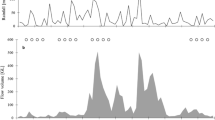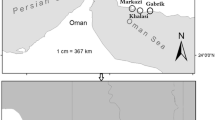Abstract
The large-scale effects of habitat alteration produced by oil-industry related pollution on the habitat use of four species of freshwater turtles (Pelusios castaneus, Pelusios niger, Pelomedusa subrufa, Trionyx triunguis) were studied in the River Niger Delta, southern Nigeria (West Africa) between 1996 and 2004. The numbers of turtle specimens observed during our study declined drastically in polluted sites, despite a nearly identical field effort. The number of specimens of all turtle species declined considerably at all habitat types, but complete disappearance in polluted areas was found only with regard to one habitat type for Trionyx triunguis and two habitat types for Pelomedusa subrufa. The mean values of species dominance and diversity indexes were not statistically significant between pristine and altered areas. Based on the interspecific similarity in proportional frequencies of turtle specimens found in each habitat type, a multivariate set of analyses (UPGMA) showed that the turtles were arranged in three ‘ecological’ clusters: a group formed by Pelomedusa subrufa at both polluted and unpolluted areas and Trionyx triunguis at polluted areas; (ii) a group formed by Pelusios castaneus in polluted areas and Pelusios niger in polluted areas; (iii) a group formed by Pelusios castaneus in unpolluted areas and Pelusios niger in unpolluted areas; however, this latter cluster was not very close, as the linkage distance was close to 80% of Euclidean distance. Habitat use similarity among turtles in both polluted and unpolluted study areas was evaluated by the use of two types of overlap formulas (Pianka and Czechanowski) and the use of Monte Carlo randomisations in order to control for the eventual role of chance in the actual data matrix. These data indicated that, for a pair of species (Pelusios niger vs. Pelusios castaneus), there was a statistically significant increase in the similarity of habitat use in the polluted areas vs. the unpolluted areas, and that this pattern was not dependent on the chance. Considering that these two species are ecologically and morphologically similar, we conclude that the most likely consequence at the community level is an increase in the intensity of interspecific competition for space between Pelusios niger and Pelusios castaneus in the polluted areas. Although the direction of the intensification of this competition process could not be easily predicted, it is likely that the species which is least adapted to life in main rivers and creeks may be disadvantaged over the other competitor. The general implications for habitat preservation are also discussed.
Similar content being viewed by others
References
Akani G.C., Barieenee I.F., Capizzi D. and Luiselli L. (1999). Snake communities of moist forest and derived savanna sites of Nigeria: Biodiversity patterns and conservation priorities. Biodivers. Conserv. 8: 629–642
Akani G.C., Politano E. and Luiselli L. (2004). Amphibians recorded in forest swamp areas of the River Niger Delta (southeastern Nigeria), and the effects of habitat alteration from oil industry development on species richness and diversity. Appl. Herpetol. 2: 1–22
Angelici F.M. and Luiselli L. (2005). Patterns of specific diversity and population size in small mammals from arboreal and ground-dwelling guilds of a forest area in southern Nigeria. J. Zool. (London) 265: 9–16
Buhlmann K.A. (1995). Habitat useterrestrial movements and conservation of the turtle Deirochelys reticularia in Virginia. J. Herpetol. 29: 173–181
Burke V.J., Lovich J.F. and Gibbons J.W. (2000). Conservation of freshwater turtles. In: Klemens, M.W. (eds) Turtle Conservation, pp 156–179. Smithsonian Institution Press, Washington, D.C.
Carbone M. (2003). Morte di un delta. Airone 260: 52–60
Christiansen J.L. (1981). Population trends among Iowa's amphibians and reptiles. Proceedings of the Iowa Academy of Science 88: 24–27
De Montclos J.M. (1994). Le Nigèria. Kurthala, Paris
Ernst C.H. and Barbour R.W. (1989). Turtles of the World. Smithsonian Institution Press, Washington, D.C
Feinsinger P., Spears E.E. and Poole R.W. (1981). A simple measure of niche overlap. Ecology 62: 27–32
Fu J., Mai B., Sheng G., Zhang G., Wang X., Peng P., Xiao X., Ran R., Cheng F., Peng X., Wang Z. and Tang U.W. (2003). Persistent organic pollutants in environment of the Pear River DeltaChina: an overview. Chemosphere 52: 1411–1422
Gibbs J.P. (1993). Importance of small wetlands for the persistence of local populations of wetland associated animals. Wetlands 13: 25–31
Gibbons J.W., Lovich J.E., Tucker A.D., Fitzsimmons N.N. and Greene J.L. (2001). Demographic and ecological factors affecting conservation and management of the Diamondback terrapin (Malaclemys terrapin) in South Carolina. Chelonian Conserv. Biol. 4: 64–76
Gotelli N.J. and Entsminger G.L. (2000). EcoSym: Null Model Software for Ecology. Aquired Intelligence Inc., New York
Luiselli L. (2001). The ghost of a recent invasion in the reduced feeding rates of spitting cobras during the dry season in a rainforest region of tropical Africa?. Acta Oecol. 22: 311–314
Luiselli L. and Akani G.C. (2003). An indirect assessment of the effects of oil pollution on the diversity and functioning of turtle communities in the Niger Delta, Nigeria. Animal Biodivers. Conserv. 26: 55–63
Luiselli L. and Angelici F.M. (2000). Ecological relationships in two Afrotropical cobra species (Naja melanoleuca and Naja nigricollis). Can. J. Zool. 78: 191–198
Luiselli L., Angelici F.M. and Akani G.C. (2002). Comparative feeding strategies and dietary plasticity of the sympatric cobras Naja melanoleuca and Naja nigricollisin three diverging Afrotropical habitats. Can. J. Zool. 80: 55–63
Luiselli L., Politano E. and Angelici F.M. (2000). Ecological correlates of the distribution of terrestrial and freshwater chelonians in the Niger DeltaNigeria: a biodiversity assessment with conservation implications. Revue d’ Ecologie (Terre et Vie) 55: 3–23
Luiselli L., Akani G.C., Politano E., Odegbune E. and Bello O. (2004). Dietary shifts of sympatric freshwater turtles in pristine and oil-polluted habitats of the Niger Delta, Southern Nigeria. Herpetol. J. 14: 57–64
Luiselli L., Akani G.C., Bello O.A., Angelici F.M., Ude L. and Politano E. 2005. Home range area may vary considerably in relation to habitat contamination in two African terrapins (Pelusios castaneus and Pelusios niger) from pristine and oil polluted habitats. Amphibia–Reptilia 26: in press.
Lutcavage M.E., Plotkin P., Witheringdon B. and Lutz P.L. (1997). Human impacts on sea turtle survival. In: Lutz, P.L. and Musick, J.A. (eds) The Biology of Sea Turtles, pp 387–409. CRC Press, Boca Raton
Magurran A.E. (1988). Ecological Diversity and its Measurement. Princeton University Press, Princeton
Mathur D. and Silver C.A. (1980). Statistical problems in studies of temperature preferences of fishes. Can. J. Fish. Aquat. Sci. 37: 733–737
Mitchell J.C. and Klemens M.W. (2000). Primary and secondary effects of habitat alteration. In: Klemens, M.W. (eds) Turtle Conservation, pp 5–32. Smithsonian Institution Press, Washington, D.C.
Moll D. (1980). Dirty river turtles. Nat. Hist. 5: 42–49
Moll E.O. and Moll D. (2000). Conservation of river turtles. In: Klemens, M.W. (eds) Turtle Conservation, pp 126–155. Smithsonian Institution Press, Washington, D.C.
Pianka E.R. (1973). Lizard species diversity. Ecology 48: 333–359
Pianka E.R. (1986). The Ecology and Natural History of Desert Lizards. Princeton University Press, Princeton
Plummer M.V. 1976. Some aspects of nesting success in the turtle, Trionyx muticus Herpetologica 32: 353–359
Schoener T.W. (1974). Resource partitioning in ecological communities. Science 185: 27–39
Schoener T.W. (1982). The controversy over interspecific competition. Am. Sci. 70: 586–595
Schoener T.W. (1983). Field experiments on interspecific competition. Am. Nat. 122: 240–285
Toft C.A. (1985). Resource partitioning in amphibians and reptiles. Copeia 1985: 1–21
Van Dijk P.P., Stuart B.L. and Rhodin A.G.J. (2000). Asian turtle trade. Chelonian Res. Monogr. 2: 1–164
Wibbels T., Killebrew F.C. and Crews D. (1991). Sex determination in Cagle's map turtle: implications for evolution, developmentand conservation. Can. J. Zool. 69: 2693–2696
Winemiller K.O. and Pianka E.R. (1990). Organization in natural assemblages of desert lizards and tropical fishes. Ecol. Monogr. 60: 27–55
Author information
Authors and Affiliations
Corresponding author
Rights and permissions
About this article
Cite this article
Luiselli, L., Akani, G.C. & Politano, E. Effects of habitat alteration caused by petrochemical activities and oil spills on the habitat use and interspecific relationships among four species of Afrotropical freshwater turtles. Biodivers Conserv 15, 3751–3767 (2006). https://doi.org/10.1007/s10531-005-1879-9
Received:
Accepted:
Published:
Issue Date:
DOI: https://doi.org/10.1007/s10531-005-1879-9




